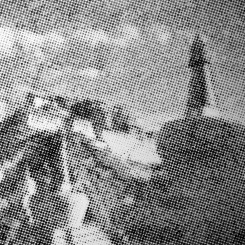Project Without Space #6
Pekin Fine Arts (241,Caochangdi, Cuigezhuang,, Chaoyang District, Beijing 100015) Dec 8 2012 – 9 Feb 2013
Fresh though the current stir over collective practice by emerging artists might appear, Chen Shaoxiong and Liu Ding (born 1962 and 1976, respectively – outside the fevered “young artist” bracket) have been working together on their Project Without Space for almost three years. Chen Shaoxiong’s practice has long enjoyed collaboration – he founded the Big Tail Elephant Group in 1991. His work unfolds with notes of insouciance filtering through situational imagination, a questioning attitude and socio-urban observation. Liu Ding’s activity as an individual artist has an acutely theoretical bent, described by one critic as having “stressed value to its breaking-point”.
Project Without Space pivots around the shared aesthetic experiences of the two artists as they adopt different conceptual approaches, exploring a new idea each time, and always questioning it. Its iterations have thus far been variously complex and productive. It was last seen in autumn 2011 (#5), where the walls were papered with photographs of the Great Wall and an LED frieze of green text ran at ceiling level. The exhibition investigated the symbolic associations attached to the image of the Great Wall, and attempted to replicate it without them, asking sardonic questions such as “Is the Great Wall made of steel and iron?”
Project Without Space #6, now on show at Pekin Fine Arts, is a comparatively inviting display. First are two square paintings of the same dimensions in colourful acrylic. These employ a combination of elements or fragments — which might be compositional, stylistic or cut from the original painting itself — gleaned from Western Modernism. On their own, they are reasonable works of art; for one who recognizes all or some of their components (what fodder for John Berger’s “Ways of Seeing” these are), they make for a strangely weightless visual experience, as if certain strings had been cut, their ends left hanging loosely in the present moment. The first painting very obviously steals — or, in another way, retains as residue — some of the monochrome patches Henri Matisse used in 1953 to build his “Snail” collage. Part of the backdrop mimics Cy Twombly: a white wash with a few words scrawled with pencil and an irreverent cluster of punch-and-dribble paint markings in acid yellow.
There are many possible directions one might pursue in viewing these works; seeing them simply as independent objects, or as forms of “copies” haunted by phantoms of the originals; one might recall Chinese artists’ eager consumption of Western art history (at first through its most obvious and famous products) as the country opened up in the late 70s. The subtraction or transposition of certain elements might lead alternatively to questions of value, and what it is truly attached to in a work of art. The paintings are accompanied by a droll, accelerated video of Chen and Liu in characteristic dialogue; they slurp drinks from plastic cups whilst talking about concepts and putting out questions and statements of this ilk: “How does one become an artist with belief?” “If we put aside their sacredness, I believe that they can be appropriated again.” “Can we still find ‘the impossible’ when everything ‘can’ be art?” They appear as friends united pleasantly by their investigations, and Chen does most of the talking. One desires to see more than just two of the paintings.
The second room is decorative at first sight. Affixed to the wall are replica Aboriginal works — naturally shaped pieces of wood adorned with multitudes of white dots, diamond shapes or globular patterns. These are born of the artists’ curiosity about Aboriginal art, a style of which they had no prior experience. The film shows them talking whilst painting simultaneously on a single wooden panel, filling in its dots and lines together, each from one end inwards. Chen says, “I tried to understand ‘aboriginal art’ by exhausting all my experience of contemporary art.” Untainted by contempt for primitivism they notice rhythm, repetition and texture — reactions transmitted in the exhibition by the simple relationship between work, video and viewer. Even though the casual visitor might not be steeped in the questions which inspired the works, one may hear them nonetheless, and at least understand that the artists’ process, as is their basic aim.
The final room of the exhibition feels somewhat auxiliary. Here are works by the individual artists — fingerprint ink paintings from Chen’s Collective Memory series (2012), and nail varnish cartoons on gold acrylic-mirror by Liu — the 2007 The Remaining Landscape series. In relation to the vocal, investigative urge pervading the other rooms, these paintings — though not without their own appeal — seem to break the thread of the show.
Thus concludes this sixth iteration of the Project Without Space — perhaps its simplest and best. One is left with the memory of hybrid paintings and their potential for inquiry, woven with the texture — visual and physical — of white flecks on wood (“What then was the ‘subjectivity’ of these works? Where were the artists? Where were ‘styles’?” the artists asked). To borrow from Edwin Schlossberg, for whom “The skill of writing is to provide a context in which other people can think,” it is a major strength of the Project Without Space that through each iteration it creates, again and again, a space where both artists and audience have choices about what to see and do.
